So, it is December 27 and Christmas is officially over. Time to clean up the Christmas stuff that landed on my desk over the past weeks. First, a Christmas present from one of our opponents during a fun drive on Christmas eve. 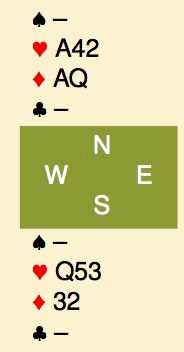 I’ve reduced it to the red suits as I don’t have the full hand records anymore and the rest of the hand isn’t that interesting anyway. There are no trumps, south is on lead and your goal is to make (at least) 3 tricks. Losing the lead once is fine, but you may not lose the lead twice.
I’ve reduced it to the red suits as I don’t have the full hand records anymore and the rest of the hand isn’t that interesting anyway. There are no trumps, south is on lead and your goal is to make (at least) 3 tricks. Losing the lead once is fine, but you may not lose the lead twice.
In case you wondered, this went wrong at the table, handing over a nice bundle of imp’s on what I though was a standard position.
A nice Christmas present and this brings up a long standing question: where do the Christmas presents come from?

Conventional Wisdom has it that Santa Claus delivers Christmas presents but CW also says that Santa Claus does not exist. Which of those statements is true?
The answer is in a little book that I found as a present under the tree “the indisputable existence of Santa Claus” (by Frey and Evans). The proof is simple, convincing and elegant. First consider the following 2 statements:
- Santa Claus does exist
- 1+1 = 2
I think that we can agree that at least one of these statements is true.
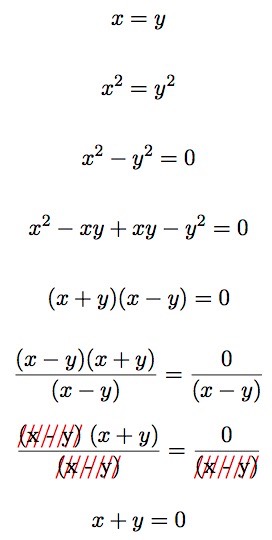
From that it follows that if one statement is false, the other one must be true. As proving whether Santa exists or not is quite complicated, let’s look at the other statement. We can write x=1 and y=1 and do a little math shown on the right. We now substitute x=1 and y=1 again what do we see:
- 1+1 = 0
As we agreed that of the 2 statements above at least one must be true, and we have shown that 1+1=0 and not 1+1=2 as you may have thought, the statement Santa Claus does exists must be true.
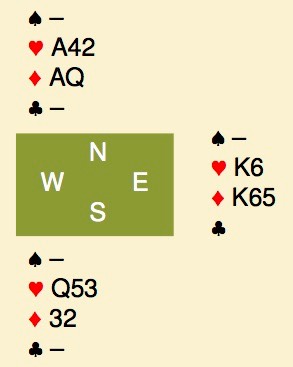
With that settled, the miniature problem: you have 2 chances to score a 3rd trick: play a heart to the ♥Q (and play east for the ♥K) or play a diamond to the ♦Q (and play west for the ♦K). It would be nice to combine the two. To do so, requires you to attack the suits in the right order.
What you should note is that trying the heart always gives the opponents a chance to win, even if east has the ♥K. Since you are allowed to lose the lead only once, you must start with the hearts: ♥3 to the ♥A and a heart back to the ♥Q. If that fails, you can always try a diamond to the ♦Q later. If you do this the other way around, diamond to the ♦Q first and it loses, the opponents can win the ♥K even if it is onside. On the right you see an example where the correct line wins over the inferior line.
This isn’t an unique problem, variations on this theme come up quite often. In general, if you have to set up a trick by losing one (or risking losing one), you should play that suit before a suit where a trick can be set up without losing the lead. Note that I’m not saying always, as there is no doubt a hand where this is not correct, but 99 out of 100 times this is the right order of play.
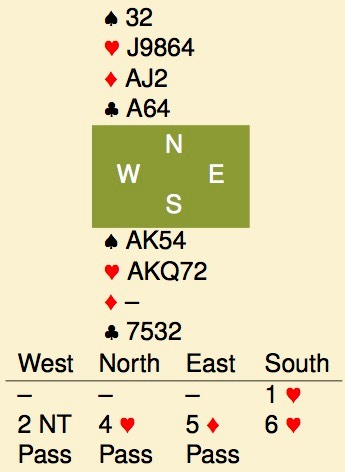
And finally another problem shown to me on another forum. The contract is 6♥, 2NT showed at least 5-5 in the minors, the ♣K is led and trumps split 2-1. Take it from there.
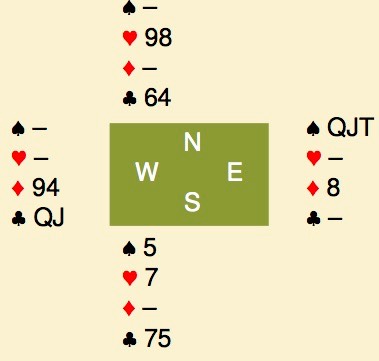
Solution: This is actually a matter of placing the cards around the table. West has shown 5-5 in the minors, leaving him with 3 cards in the majors. Trumps were 2-1 so that makes his shape 2-1-5-5, 1-2-5-5, 1-1-6-5 or 1-1-5-6. Let’s assume for a second that west’s shape is 2-1-5-5. East will then hold a 5-2-5-1 shape.
We can now proceed by eliminating the pointed suits: win the ♣A (if that is ruffed, west was 1-1-5-6 and the contract can never be made), play the ♦A and ruff a diamond, 2 trumps, ♠AK and spade ruff, finally a diamond ruff. That leaves these cards:
Play a spade, west shows out and discard a club from dummy. East has to return a spade or diamond, allowing you to ruff in hand while discarding the last losing club from dummy.
